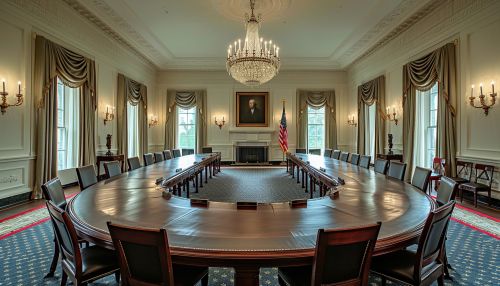Cabinet of the United States
Overview
The Cabinet of the United States is a body composed of the most senior appointed officers of the executive branch of the federal government of the United States, and its existence dates back to the first American President, George Washington. The Cabinet's role, inferred from the language of the Opinion Clause (Article II, Section 2, Clause 1) of the Constitution is to serve as an advisory body to the President of the United States.


Composition and Appointments
The Cabinet includes the Vice President and the heads of 15 executive departments — the Secretaries of Agriculture, Commerce, Defense, Education, Energy, Health and Human Services, Homeland Security, Housing and Urban Development, Interior, Labor, State, Transportation, Treasury, and Veterans Affairs, as well as the Attorney General. In addition to these fifteen, other high-ranking officials of the executive branch may be designated by the President to be members of the Cabinet. Cabinet members are appointed by the President and they are confirmed by the Senate. They serve at the pleasure of the President, which means that the President may dismiss them or reappoint them (to other posts) at will.
Role and Functions
The primary function of the Cabinet is to advise the President on any subject he or she may require relating to the duties of each member's respective office. As part of the executive branch, Cabinet members often sit on the National Security Council, and are involved in high-level discussions on important issues. The Cabinet meets weekly to discuss matters of policy and administration.
History
The Cabinet's role has changed over time. In the early days of the Republic, it was a forum for the President to seek advice and consent on major policy decisions. Over time, however, the Cabinet's role has evolved into a more managerial one, where the Cabinet members manage large bureaucracies and implement the President's agenda.
Current Cabinet
The current Cabinet is composed of the following members: the Vice President, the Secretary of State, the Secretary of the Treasury, the Secretary of Defense, the Attorney General, the Secretary of the Interior, the Secretary of Agriculture, the Secretary of Commerce, the Secretary of Labor, the Secretary of Health and Human Services, the Secretary of Housing and Urban Development, the Secretary of Transportation, the Secretary of Energy, the Secretary of Education, the Secretary of Veterans Affairs, and the Secretary of Homeland Security.
